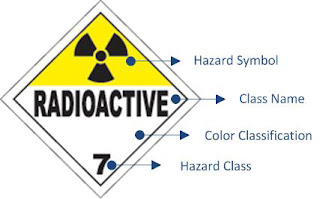 |
| Radioactive Cartoon Truck |
While fun to think about, radioactive materials
can’t be identified in such an obvious way. However there is a labeling
standard detailed by the US Department of Transportation (DOT) that requires
trucks to post what type of material they are carrying. The label found on
these trucks is a symbol in a colored diamond. These signs may seem really cryptic
but they can tell you a lot about what is in that truck. These signs or
placards comply with DOT regulations for trucks shipping within the United
States and Canada.
What
do all those symbols and numbers mean?
There are four relevant items indicated by these
signs as noted by the diagram below.
 |
| Class 7 Hazard Placard |
Hazard Symbol: An alternate method for identifying the material contained
in the tank
Class Name: A one or two word description of the contents of the tank
Color Classification: The
color of the placard provides some detail relating to the type of material
Red: Flammable Material Red and White: Flammable Solid or Spontaneously Combustible Material
Orange: Explosives
Yellow: Oxidizer
Green: Nonflammable Material
Blue: Dangerous when Wet
White: Inhalation Hazard and Poisonous
White and Yellow: Radioactive
Black and White: Corrosive
White with Black Stripes: Misc Hazardous Material
Hazard Class: Shipped materials are categorized in one of 9 classes
Class 1: Explosives
Class 2: Gases – Compressed or Refrigerated
Class 3: Flammable and/or Combustible Liquid
Class 4: Flammable Solids – Spontaneously Combustible and/or Water Reactive
Class 5: Oxidizing Materials – Organic Peroxide
Class 6: Poisonous and/or Infectious Substances
Class 7: Radioactive Materials
Class 8: Corrosive Materials
Class 9: Misc. Hazardous Materials
Sometimes in place of the class
name, a classification number is used. This is called the United Nations
identification number. These numbers are listed on a chart that further
classifies the contents of the tank. This number can also be denoted separately
from the hazard placard in the form of a rectangular orange label.
 |
| Petroleum gases, liquefied |
http://en.wikipedia.org/wiki/UN_number
For those of you with a smart phone on hand, there is an app available that provides a database search for the UN numbers. You can get a general description and if you want more information you can click on the listing for more details. The app for Android is called DOT Placards and the app for Apple is called Placard+.
Should I be concerned if I see a truck hauling radioactive material?
There are many regulations dictating how radioactive material can be shipped. Depending on the radiological strength, these materials fall into 4 different categories:
- Exempt (not strong enough to pose a health hazard)
- Low-level Waste (LLW)
- Intermediate-level Waste (ILW)
- High-level Waste (HLW)
“The objective of the regulations is
to protect people and the environment from the effects of radiation during the
transport of radioactive material.
Protection is achieved by:
- containment of radioactive contents;
- control of external radiation levels;
- prevention of criticality; and
- prevention of damage caused by heat.
The fundamental principle applied to
the transport of radioactive material is that the protection comes from the
design of the package, regardless of how the material is transported.”
So rest assured that even in the
event of an accident, the radioactive material is securely packed to prevent
accidental radiation exposure.
References:
World Nuclear Association, “Transport of Radioactive Materials” http://www.world-nuclear.org/Information-Library/
San Bernardino County Fire Dept, Hazardous Materials Division, “Emergency Response Program” http://www.sbcfire.org/hazmat/er.aspx
